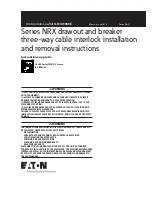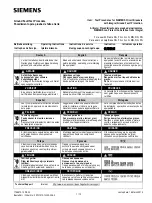
PSXX Manual Rev: A Software Rev: F
16
Low Current System Trip Current Settings:
●
For the Digitrax Zephyr [DCS50, DCS51, DCS52], setting values of CV49=01,
02, & 03 is OK.
●
The NCE Power Cab should use the default value of CV49=02.
●
For the PowerCab cv49=1 is ok too.
●
Most 5 amp boosters should be happy with CV49 = 0-5
CV50 Block Occupied Detection Method
●
Default = 0.
●
CV50=0 - Block Current controls Block Occupied output.
●
CV50=1 - Photocell controls Block Occupied output.
●
Block current is used to indicate the block is occupied and the train is
somewhere within the block.
●
Photo cell is used to indicate the train is at a specific point in the block
CV52 Enable Discrete Control of DCC2 output
●
Default = 0, input is disabled
●
CV52=66 enables discrete on/off control of DCC2 output using J4-1 and J4-2
inputs.
●
Any other value disables the J4-1 and J4-2 inputs.
●
When enabled, a connection from J4-1 to J4-2 turns DCC2 off.
●
DCC1 is the connection from J1-1 to J2-1. It is a copper trace. DCC2 is the
connection from J1-2 to J2-2 and goes through the solid state switch which
allows this connection to be open or closed (OFF or ON).
CV53
Enable Block Current Auto-Calibration
●
Default = 0, no calibration.
●
CV53=66 enables Block Current Auto-Calibration the next time the PSXX is
turned on.
●
CV53 is set to 66, power is removed, and JP1 is returned to the 2-3 position.
●
When the PSXX is next turned on, it will measure the average Block Current
and store the value in CV56.
●
This will prevent the Block Occupied output from turning on due to any
background current (such as from lights, switch motors, etc.) in the block
●
The Block Occupied will turn on if the current in the block increases above the
background value due to block occupancy
●
The PSXX automatically returns the value to 0 after the block is calibrated.
CV54
Block Current Off Hysteresis
sets the current level at which the PSXX turns
on the Block Occupied output. This allows you to set a level above the leakage
current on the track to prevent false indications.
●
Default = 5
●
The Block Occupied output will be OFF if the detected current is less than the
sum of CV56 and CV54.
●
In general, this value should only be adjusted if the Block Occupied output will
not turn off and you have done an Auto Calibration (see CV53).








































